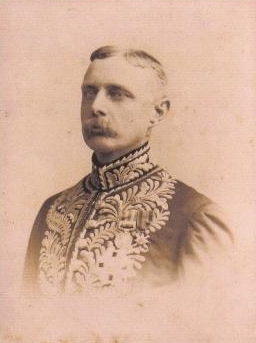William Edward Maxwell facts for kids
Quick facts for kids
Sir William Edward Maxwell
|
|
|---|---|
 |
|
| Governor of the Gold Coast | |
| In office 7 April 1895 – 6 December 1897 |
|
| Monarch | Queen Victoria |
| Preceded by | William Brandford Griffith |
| Succeeded by | Frederick Mitchell Hodgson |
| Acting Governor of the Straits Settlements | |
| In office 30 August 1893 – 1 February 1894 |
|
| Monarch | Queen Victoria |
| Preceded by | Sir Cecil Clementi Smith |
| Succeeded by | Sir Charles Mitchell |
| 6th Colonial Secretary of the Straits Settlements | |
| In office 9 March 1892 – 1895 |
|
| Monarch | Queen Victoria |
| Governor | Sir Cecil Clementi Smith Sir Charles Mitchell |
| Preceded by | Sir John Frederick Dickson Arthur Philip Talbot (Acting) |
| Succeeded by | James Alexander Swettenham |
| British Resident of Selangor | |
| In office 1889–1892 |
|
| Preceded by | Frank Athelstane Swettenham John Pickersgill Rodger (Acting) |
| Succeeded by | William Hood Treacher |
| Personal details | |
| Born | 5 August 1846 |
| Died | 10 December 1897 (aged 51) sea off Grand Canary |
| Spouse |
Lillias Grant Aberigh-Mackay
(m. 1870) |
| Children | Sir William George Maxwell |
| Parents |
|
| Occupation | Colonial administrator |
Sir William Edward Maxwell (born August 5, 1846 – died December 14, 1897) was an important British official. He worked in different parts of the world. He served as the Colonial Secretary of the Straits Settlements (which included places like Singapore) and later as the Governor of the Gold Coast (now Ghana).
Contents
Who Was Sir William Maxwell?
William Edward Maxwell was born on August 5, 1846. His father, Sir Peter Benson Maxwell, was a high-ranking judge. He was the Chief Justice of the Straits Settlements. This area was a group of British territories in Southeast Asia.
Starting His Career
William followed in his father's footsteps. He also worked in law and served in the courts. These courts were located in the Straits Settlements.
In 1883, William Maxwell got a new job. He became the Commissioner of Land Titles. This meant he was in charge of land records. He also joined the Executive and Legislative Councils. These councils helped make decisions and laws for the settlements.
Working in Southeast Asia
In 1889, Maxwell became the British Resident of Selangor. This is a state in modern-day Malaysia. He then became the Colonial Secretary of the Straits Settlements in 1892. This was a very important role. From August 1893 to February 1894, he even served as the acting governor.
Governor of the Gold Coast
In 1895, Maxwell was given an even bigger role. He became the Governor of the Gold Coast. This area is now the country of Ghana in West Africa.
The Anglo-Ashanti War
During his time as governor, a war broke out. It was the fourth Anglo-Ashanti War. It is also known as the "Second Ashanti Expedition." This war happened in 1895 between the British and the Asante Empire.
Maxwell used an old treaty from 1874. The terms of this treaty were very difficult for the Asante people to meet. When the Asante King, Asantehene Agyeman Prempeh, could not follow the treaty's rules, Maxwell took action. He had the King arrested. The King's mother, father, brother, uncles, and many advisors were also arrested.
They were later sent far away to the Seychelles islands. They did not return to the Gold Coast until the 1920s.
His Final Days
Sir William Maxwell became very sick with malaria. He died at sea near the Canary Islands. He was buried at sea.
He had married Lillias Grant Aberigh-Mackay in 1870. They had children together. There is a special memorial tablet for him. It is at the Holy Trinity Cathedral in Accra, Ghana. The tablet honors his dedication to his work. It mentions how he helped bring the Kingdom of Ashanti under British control. It also says he got sick while working to bring peace to tribes in the northern areas.
Before he died, he asked his niece to burn his private letters and diaries. He did not want anyone to read them. His niece followed his wishes.
Awards and Recognition
Sir William Maxwell received several important awards. In 1885, he was given the Companion of the Most Distinguished Order of St. Michael and St. George (CMG). This award recognized his service. In 1896, he was honored again. He became a Knight Commander of the Most Distinguished Order of St. Michael and St. George (KCMG). This is why he is called "Sir."
See also
- Maxwell, William Edward

